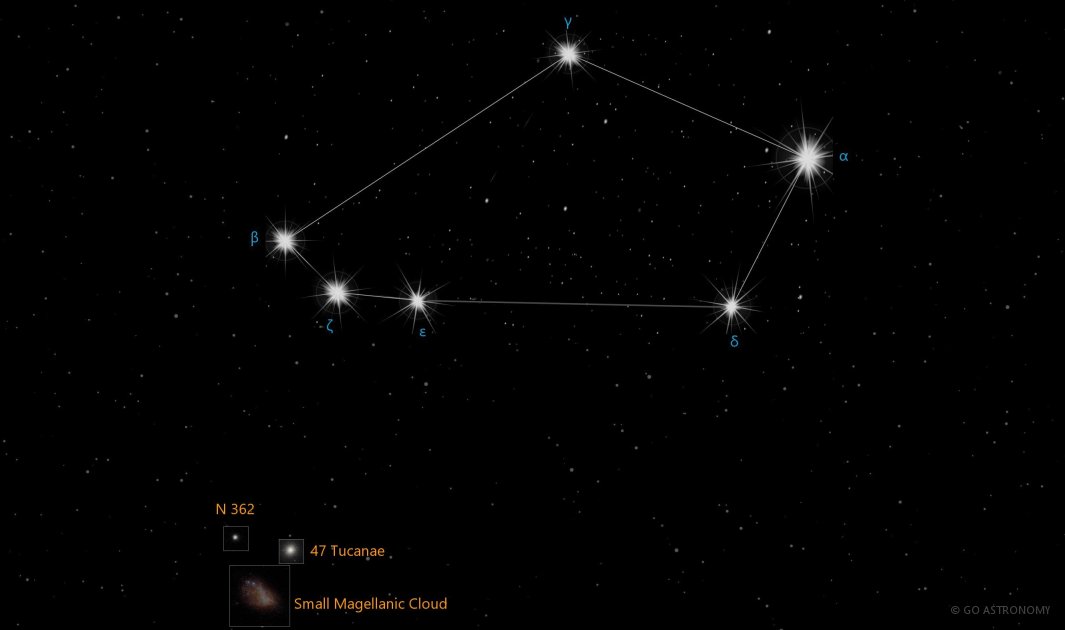Tucana, the Toucan (Tuc)
(too-KAY-nuh)
The Southern constellation of Tucana, the Toucan, is best viewed in Fall during the month of November.
Tucana is the 48th largest constellation. It's brightest star is Alpha Tucanae at magnitude 2.87. The boundary of the Tucana constellation contains 9 stars that host known exoplanets.
Tucana is a circumpolar constellation, so is visible year-round in the Southern hemisphere. Conversely, it is not visible in the opposite hemisphere.
- Pronunciation:
- too-KAY-nuh
- Meaning:
- Toucan
- Genitive:
- Tucanae
- Abbreviation:
- Tuc
- Constellation Family:
- Bayer
- Hemisphere:
- Southern
- Quadrant:
- SQ4
- Visibility:
- 25° N - 90° S
- Best viewing month*:
- November
- Area:
- 295 sq. degrees
- Size:
- 48th largest
- Circumpolar** (N=northern, S=southern):
- S circumpolar
- Right Ascension (avg):
- 23h 50m
- Declination (avg):
- -63°
- Brightest star:
- Alpha Tucanae (2.87)
- Stars with planets:
- 9
- X-ray stars:
- 2 (binary) stars
- Messier objects:
- |
Brightest Stars in Tucana
The 10 brightest stars in the constellation Tucana by magnitude.
- Star
- Magnitude
- Spectral class
- Alpha Tucanae (α Tuc)
- 2.87
- K3III
- Gamma Tucanae (γ Tuc)
- 3.99
- F1III
- Zeta Tucanae (ζ Tuc)
- 4.23
- F9V
- Kappa Tucanae (κ Tuc)
- 4.25
- F6IV
- Beta Tucanae (β1 Tuc)
- 4.34
- B9V
- Epsilon Tucanae (ε Tuc)
- 4.49
- B9IV
- Delta Tucanae (δ Tuc)
- 4.5
- B8V
- Beta Tucanae (β2 Tuc)
- 4.51
- A2V
- Nu Tucanae (ν Tuc)
- 4.91
- M4III
- Eta Tucanae (η Tuc)
- 5
- A1V
Star Clusters in Tucana
The most notable and easy-to-find star clusters in the constellation Tucana . Also see all star clusters.
Galaxies in Tucana
The most notable galaxies in the constellation Tucana. Also see all galaxies.
Milky Way Satellites in Tucana
Dwarf satellite galaxies that orbit the Milky Way Galaxy located in the constellation Tucana. Also see all Milky Way satellite galaxies.
- Galaxy name
- Alt name
- Magnitude
- Small Magellanic Cloud
- 2.7
- Tucana II
- Tucana IV
- Tucana III
- Tucana V
* Constellation shown for northen hemisphere skies. For the southern hemisphere, constellations appear rotated 180 degrees (upside-down and left-right reversed) from what is shown. Remember that seasons are reversed too - summer in northern latitudes is winter in southern latitudes.
** Circumpolar constellations are visible year-round in the hemisphere listed (and not at all in the opposite hemisphere).





